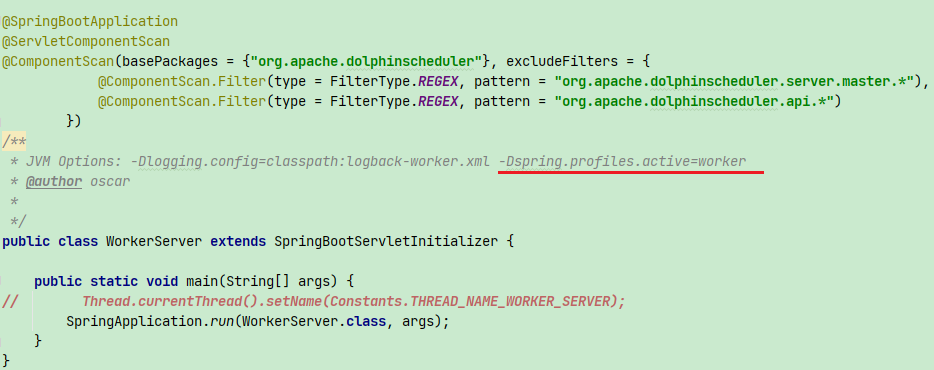一. 前言
由于在项目中使用Maven打包部署的时候,经常由于配置参数过多(比如Nginx服务器的信息、ZooKeeper的信息、数据库连接、Redis服务器地址等),导致实际现网的配置参数与测试服务器参数混淆,一旦在部署的时候某个参数忘记修改了,那么就必须重新打包部署,这确实让人感到非常头疼。因此就想到使用Spring中的Profile来解决上面描述的问题,并且在此记录一下其使用的方式,如果有不对的地方,请指正!(感谢)。
本文从如下3方面探讨Spring的Profile:
-
Spring中的Profile是什么
-
为什么要使用Profile
-
如何使用Profile
二. Spring中的Profile 是什么?
Spring中的Profile功能其实早在Spring 3.1的版本就已经出来,它可以理解为我们在Spring容器中所定义的Bean的
逻辑组名称
,只有当这些Profile被激活的时候,才会将Profile中所对应的Bean注册到Spring容器中。举个更具体的例子,我们以前所定义的Bean,当Spring容器一启动的时候,就会一股脑的全部加载这些信息完成对Bean的创建;而使用了Profile之后,它会将Bean的定义进行更细粒度的划分,将这些定义的Bean划分为几个不同的组,当Spring容器加载配置信息的时候,首先查找激活的Profile,然后只会去加载被激活的组中所定义的Bean信息,而不被激活的Profile中所定义的Bean定义信息是不会加载用于创建Bean的。
三. 配置Spring profile
在介绍完Profile以及为什么要使用它之后,下面让我们以一个例子来演示一下Profile的使用,这里还是使用传统的XML的方式来完成Bean的装配。
3.1 例子需要的Maven依赖
由于只是做一个简单演示,因此无需引入Spring其他模块中的内容,只需引入核心的4个模块+测试模块即可。
<properties>
<project.build.sourceEncoding>UTF-8</project.build.sourceEncoding>
<!--指定Spring版本,该版本必须大于等于3.1-->
<spring.version>4.2.4.RELEASE</spring.version>
<!--指定JDK编译环境-->
<java.version>1.7</java.version>
</properties>
<dependencies>
<dependency>
<groupId>org.springframework</groupId>
<artifactId>spring-core</artifactId>
<version>${spring.version}</version>
</dependency>
<dependency>
<groupId>org.springframework</groupId>
<artifactId>spring-beans</artifactId>
<version>${spring.version}</version>
</dependency>
<dependency>
<groupId>org.springframework</groupId>
<artifactId>spring-context</artifactId>
<version>${spring.version}</version>
</dependency>
<dependency>
<groupId>org.springframework</groupId>
<artifactId>spring-expression</artifactId>
<version>${spring.version}</version>
</dependency>
<dependency>
<groupId>org.springframework</groupId>
<artifactId>spring-test</artifactId>
<version>${spring.version}</version>
<scope>test</scope>
</dependency>
<dependency>
<groupId>junit</groupId>
<artifactId>junit</artifactId>
<version>4.12</version>
<scope>test</scope>
</dependency>
</dependencies>
<build>
<plugins>
<plugin>
<groupId>org.apache.maven.plugins</groupId>
<artifactId>maven-compiler-plugin</artifactId>
<version>2.3.2</version>
<configuration>
<source>${java.version}</source>
<target>${java.version}</target>
</configuration>
</plugin>
</plugins>
</build>
3.2 例子代码
本例使用
@ActiveProfiles
注解来激活profile;
package com.panlingxiao.spring.profile.service;
/**
* 定义接口,在实际中可能是一个数据源
* 在开发的时候与实际部署的时候分别使用不同的实现
*/
public interface HelloService {
public String sayHello();
}
定义生产环境使用的实现类:
package com.panlingxiao.spring.profile.service.produce;
import org.springframework.beans.factory.annotation.Value;
import org.springframework.stereotype.Component;
import com.panlingxiao.spring.profile.service.HelloService;
/**
* 模拟在生产环境下需要使用的类
*/
@Component
public class ProduceHelloService implements HelloService {
//这个值读取生产环境下的配置注入
@Value("#{config.name}")
private String name;
public String sayHello() {
return String.format("hello,I'm %s,this is a produce environment!",
name);
}
}
定义开发下使用的实现类:
package com.panlingxiao.spring.profile.service.dev;
import org.springframework.beans.factory.annotation.Value;
import org.springframework.stereotype.Component;
import com.panlingxiao.spring.profile.service.HelloService;
/**
* 模拟在开发环境下使用类
*/
@Component
public class DevHelloService implements HelloService{
//这个值是读取开发环境下的配置文件注入
@Value("#{config.name}")
private String name;
public String sayHello() {
return String.format("hello,I'm %s,this is a development environment!", name);
}
}
定义配置Spring配置文件:
<?xml version="1.0" encoding="UTF-8"?>
<beans xmlns="http://www.springframework.org/schema/beans"
xmlns:xsi="http://www.w3.org/2001/XMLSchema-instance" xmlns:context="http://www.springframework.org/schema/context"
xmlns:util="http://www.springframework.org/schema/util"
xsi:schemaLocation="http://www.springframework.org/schema/beans http://www.springframework.org/schema/beans/spring-beans-4.2.xsd
http://www.springframework.org/schema/context http://www.springframework.org/schema/context/spring-context-4.2.xsd
http://www.springframework.org/schema/util http://www.springframework.org/schema/util/spring-util-4.2.xsd">
<!-- 定义开发的profile -->
<beans profile="development">
<!-- 只扫描开发环境下使用的类 -->
<context:component-scan base-package="com.panlingxiao.spring.profile.service.dev" />
<!-- 加载开发使用的配置文件 -->
<util:properties id="config" location="classpath:dev/config.properties"/>
</beans>
<!-- 定义生产使用的profile -->
<beans profile="produce">
<!-- 只扫描生产环境下使用的类 -->
<context:component-scan
base-package="com.panlingxiao.spring.profile.service.produce" />
<!-- 加载生产使用的配置文件 -->
<util:properties id="config" location="classpath:produce/config.properties"/>
</beans>
</beans>
开发使用的配置文件,dev/config.properties:
name=Tomcat
生产使用的配置文件,produce/config.properties:
name=Jetty
编写测试类:
package com.panlingxiao.spring.profile.test;
import org.junit.Test;
import org.junit.runner.RunWith;
import org.springframework.beans.factory.annotation.Autowired;
import org.springframework.test.context.ActiveProfiles;
import org.springframework.test.context.ContextConfiguration;
import org.springframework.test.context.junit4.SpringJUnit4ClassRunner;
import com.panlingxiao.spring.profile.service.HelloService;
@RunWith(SpringJUnit4ClassRunner.class)
@ContextConfiguration(locations="classpath:spring-profile.xml")
/*
* 使用注册来完成对profile的激活,
* 传入对应的profile名字即可,可以传入produce或者development
*/
@ActiveProfiles("produce")
public class TestActiveProfile {
@Autowired
private HelloService hs;
@Test
public void testProfile() throws Exception {
String value = hs.sayHello();
System.out.println(value);
}
}
填写测试类中
@ActiveProfiles(" ")
注解中的profile名称(produce或者development)选择注入不同的bean!
输入
development
:

输入
dev
:

四. 激活Profile的其他几种方式
上面介绍了如何使用Profile以及在单元测试的环境下激活指定的Profile,除了使用
@ActiveProfiles
注解来激活profile外,Spring还提供了其他的几种激活Profile,这些方式在实际的开发中使用的更多。
Spring通过两个不同属性来决定哪些profile可以被激活(注意:profile是可以同时激活多个的),一个属性是
spring.profiles.active
和
spring.profiles.default
。
这两个常量值在Spring的AbstractEnvironment中有定义,查看AbstractEnvironment源码:
/**
* Name of property to set to specify active profiles: {@value}. Value may be comma
* delimited.
* <p>Note that certain shell environments such as Bash disallow the use of the period
* character in variable names. Assuming that Spring's {@link SystemEnvironmentPropertySource}
* is in use, this property may be specified as an environment variable as
* {@code SPRING_PROFILES_ACTIVE}.
* @see ConfigurableEnvironment#setActiveProfiles
*/
public static final String ACTIVE_PROFILES_PROPERTY_NAME = "spring.profiles.active";
/**
* Name of property to set to specify profiles active by default: {@value}. Value may
* be comma delimited.
* <p>Note that certain shell environments such as Bash disallow the use of the period
* character in variable names. Assuming that Spring's {@link SystemEnvironmentPropertySource}
* is in use, this property may be specified as an environment variable as
* {@code SPRING_PROFILES_DEFAULT}.
* @see ConfigurableEnvironment#setDefaultProfiles
*/
public static final String DEFAULT_PROFILES_PROPERTY_NAME = "spring.profiles.default";
如果当
spring.profiles.active
属性被设置时,那么Spring会优先使用该属性对应值来激活Profile。当spring.profiles.active没有被设置时,那么Spring会根据
spring.profiles.default
属性的对应值来进行Profile进行激活。
如果上面的两个属性都没有被设置,那么就不会有任务Profile被激活,只有定义在Profile之外的Bean才会被创建
。
我们发现这两个属性值其实是Spring容器中定义的属性,而我们在实际的开发中很少会直接操作Spring容器本身,所以如果要设置这两个属性,其实是需要定义在特殊的位置,让Spring容器自动去这些位置读取然后自动设置,这些位置主要为如下定义的地方:
-
作为虚拟机的系统参数
-
作为SpringMVC中的DispatcherServlet的初始化参数
-
作为Web 应用上下文中的初始化参数
-
作为JNDI的入口
-
作为环境变量
-
使用@AtivceProfiles 来进行激活
例
: 作为虚拟机的系统参数
在服务启动时在IDEA中设置VM参数:

我们在实际的使用过程中,可以定义默认的profile为开发环境,当实际部署的时候,主需要在实际部署的环境服务器中将spring.profiles.active定义在环境变量中来让Spring自动读取当前环境下的配置信息,这样就可以很好的避免不同环境而频繁修改配置文件的麻烦。
转自:
https://www.jianshu.com/p/948c303b2253